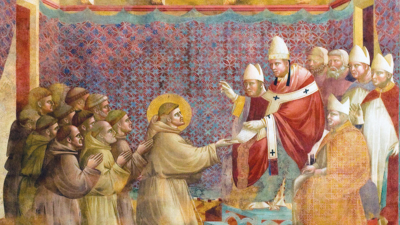Franciscan Rules of Life
St. Francis of Assisi
When Francis returned there were local problems of formation, discipline, and mission, and an even larger issue. It was not clear that the Franciscans were actually a “religious order.”

The year is 1220 and Francis has just announced his decision to step down as “leader” of the Franciscan brothers. In the previous article (Fork in the Road), I described Francis’ reason for stepping down. Francis had already seen the effects of a vacuum in spiritual authority brought about by his year-long absence while in the Middle East. It is in leaving to his “vicar” and to the Roman Church the care of making decisions of a normative or disciplinary type that he could hope to preserve a superior authority, of a spiritual type, that would only have been diminished in the heat of daily administration.
Francis’ absence had brought the friars to a liminal moment in the growth of the fraternity; betwixt-and-between the times when all knew Francis and could learn by his example to a time when most friars had never met Francis, especially the friars in Spain, France, the British Isles, and among the Germanic tribes. By many estimates, the fraternity was in need of administration and management.
The friars were being pulled and pushed in many directions. Some friars wanted a more structured life such as the monastics, and yet still wanted their degrees of freedom. Other friars only wanted to live in hermitages and beg for food. Still others were moving to the new cities and serving the growing population of homeless and beggars. Meanwhile the Pope and Curia were hinting that the friars should become priests in order to serve the cities – even as more men, already ordained, were joining the friars, and thus leaving the diocese and monasteries. The complaints from bishops and abbots were mounting up as the friars wandered through the diocesan areas preaching and holding penance services apart from the local priests and bishops – and in many cases, collecting wills and benefices.
A bishop like Jacques de Vitry, who, though he really admired the friars, did not hide his concern about the evolution under way when he wrote in 1220, a little before Francis’ return: “This religious movement appears really dangerous to me because it admits into its group not only mature men but even adolescents and unprepared individuals. And whereas they should have begun by exercising for a time a regular discipline and by demonstrating their worthiness, here these brothers are sent two by two throughout the whole world.”
Into this growing problem stepped Cardinal Hugolino, already a friend of the friars and counselor to St. Francis. Hugolino recognized When Francis visited Pope Innocent III in 1209, the pope verbally approved (or did he?) a Rule of Life that was written down in few words. In 1216, the 4th Lateran Council ruled that no new religious orders could be formed: all new groups would be absorbed into existing ways of life like the Benedictines or Canons of St. Augustine. Many bishops and abbots were pointing out this juridical detail. Hugolino recognized the uniqueness of the charism of St. Francis and his brothers and was determined that it not be lost to the church.
Hugolino was able to hold off the critics because of his office and presence in the papal curia, and soon enough he would become Pope Gregory IX. But he needed Francis to write down a Rule of Life that would capture the uniqueness of this Franciscan project and would satisfy the canonists (lawyers) in Rome.
In late 1220 or early 1221, Francis and some companions undertook the writing of the “early rule” also known as the Rule of 1221. It is a potpourri of spiritual reflections, exhortations, and communal and individual norms of behavior – all animated by extensive citations from Scripture. While it was intended to serve a juridical purpose for Rome; for Francis it was a reminder of the principles of life in minoritas: “The rule and life of these friars is this: to live in obedience, in chastity and without anything of one’s own, and to follow the teaching and the footprints of Our Lord Jesus Christ who said, ‘If you wish to be perfect, go and sell all that you have and give it to the poor, and you will have treasure in heaven; and come and follow me’.” (Early Rule 1:1-2)
Even in the writing of a juridical rule (hierarchy of authority), Francis was attempting to describe a way of living in an upside down hierarchy in which the saints in this life are at the bottom, subject to others. As Vauche describes, “For Francis, the root of evil, from which neither individuals nor groups escape, resides in an egocentric vision of the world and human relationships. The quintessential sin for the human person consists in appropriating to oneself one’s own will and to ‘rejoice in the good that the Lord says and does in oneself.’” And so Francis set out to write a rule that would lead the friars on a life journey to be totally possessed by God, to know that all goods in this life are a gift from God, and that it is God to whom all these gifts should be returned in a prayer of praise and gratitude. To live in poverty is to come to the realization that the only true wealth is that of shared love and loving service – this is the meaning of minoritas.